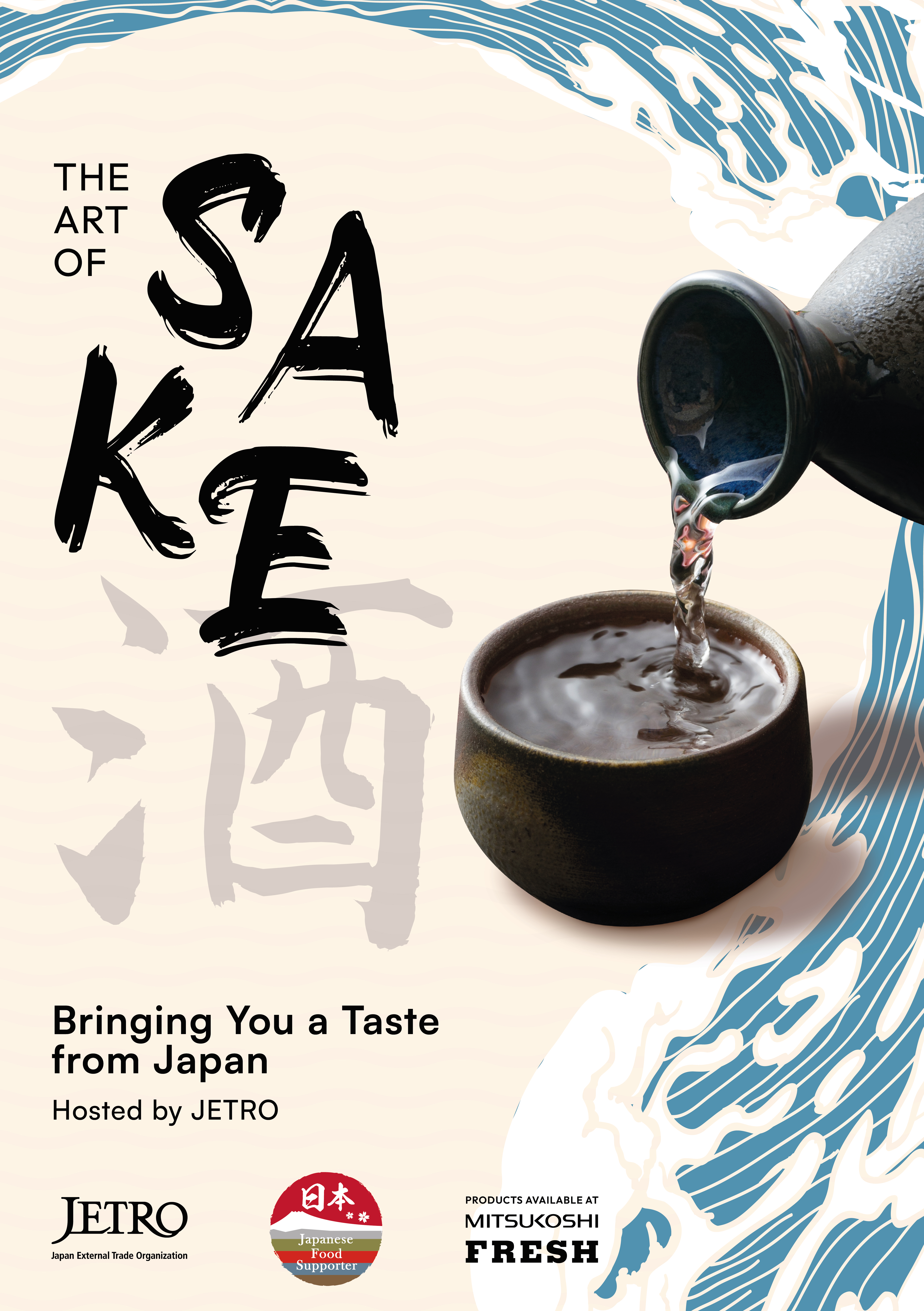[Event] Promotion of Japanese Food Product: Art of Sake
Feb 01, 2023
Bold, Refreshing, and Timeless: How Japan Shares its Culture through Sake
Savor the taste of Japan's rich culture and enduring legacy in every sip
Created and perfected in the Land of the Rising Sun, sake is one of Japan’s greatest gifts to the world. This colorless elixir is said to be the drink of the Shintō kami (gods). Today, it is served at festivals and often given as offerings to the gods.
Due to its importance in Japanese culture, sake deserves a special ceremony before being enjoyed — a ritual to prepare the sake before drinking. It is often served warm in a tokkuri (porcelain bottle) and poured into small porcelain cups of different kinds, ochoko being the most common, or in more recent years, in sake glassware. However, sake of premium quality is served chilled or on the rocks because of its delicate flavor.
Sake is one of — if not the oldest — beverage in Japan. The first record of sake production goes way back to the 3rd century CE after wet rice cultivation was introduced in Japan. It was first produced by the imperial court, shrines, and temples, but in the 12th century, mass production of sake started. Despite the modernization, tradition and culture remain deeply imbued in the process of making sake. From the careful selection and polishing of rice, to the making and use of koji – an enzyme unique to the production of sake, to the alcoholic fermentation; each step requires knowledge and skills by the sake brewer whose experience and artisanship made it possible to preserve the long and rich history of this truly symbolic Japanese beverage.
Today, sake can still be found in many scenes of Japanese society and culture. For instance, in traditional Japanese weddings, sharing of sake between the bride and groom symbolizes the tying together of a relationship. While sake is enjoyed during the New Year’s Eve to ask for good health and prosperity.
The Art of Sake
|
As Japan’s national beverage, the Japan External Trade Organization (JETRO), has decided to bring the taste of Japan to the Philippines through “Art of Sake.” Held at the Garden Pavilion of Grand Hyatt Manila in Bonifacio Global City (BGC), Taguig City, it was an intimate sake appreciation event that brought together the best of the best in the food and beverage industry in the Philippines to experience the different taste of sake.
At the “Art of Sake”, attendees were able to learn more about sake through the installed exhibit about the history of Japan’s national beverage, a presentation about the differences between Sake and Shochu by Mr. Takato Ishimoto of Mitsukoshi Retail, Inc., and a panel discussion joined by Japanese Sake brand representatives namely Mr. Yukimura Sato of Ozeki, Mr. Eric Wang of Shichiken, Mr. Gelo Clavano, Managing Partner of Wano Craft Market, and Mr. Ryan Joseph of the Philippine Wine Merchants (PWM). |

|
During the exchange led by WSET Sake Level 1 certificate awardee Ms. Gail Sotelo, the panel members guided the attendees into the art of sake by delving deeper into the different categories of sake, distinguishing each one through a tasting session featuring eight of the best sake currently available in the Philippine market.
Attendees enjoyed Japanese sake brands like (1) Honjozo Karatanba and (2) Junmai Yamadanishiki by Ozeki from the Kyoto Prefecture; the crowd favorite (3) Shichiken Yama no Kasumi Sparkling Sake from the Yamanashi Prefecture; (4-6) Dassai 45, 39, and 23 by Dassai from the Yamaguchi Prefecture; (7) Zaku Junmai Daiginjo and (8) Kakurei Yukiotoko Junmai from Wano Trading.
The “Art of Sake” panel discussion was lively and yielded many interesting questions from the audience. In much detail, the panel members also discussed the different types and characteristics of rice used in producing sake and how each polishing rate determines the category of sake being produced.
Many were pleasantly surprised to find out that enjoying sake in moderation has numerous health benefits. Mr. Yukimura Sato of Ozeki shared that geishas used to wash their face with a combination of sake and water, which gives them perfect skin. Some even take “sake baths” to maintain their good skin.
Of great interest among the guests was the discussion about pairing sake with food. The panel members explained the different characteristics of sake brewing and proper serving style, which helps determine the best flavor profiles to pair with sake. Sake pairs well with most dishes due to its low acidity, subtle sweetness, and rich amino acid content, which enhances umami flavors. Mr. Nakata Shunsuke, Managing Partner and Sake Specialist of WANO Trading, shared during the panel discussion that sake is best paired with “salty, fishy, and spicy flavors”, making it ideal for Filipino dishes with bagoong (shrimp paste) like Pinakbet.
A general rule of thumb is if it pairs well with rice, it will go well with sake. Aside from being practically hangover-free, sake is also known to improve the flavors of food. When paired correctly, sake can highlight hidden flavors of the ingredients, which enhances the dish's flavor profile. It can also serve as a palate cleanser, preparing one’s taste buds for the next dish.
At the end of the day, sake is best enjoyed the way you want it to be enjoyed. Mr. Eric Wang of Shichiken encouraged the audience, “Don’t be afraid. Pair, explore.” Meanwhile, for those who are gaining an interest in sake, Mr. Ryan Joseph of Philippine Wine Merchants shared, “Your palate is like a muscle that needs to be trained and the best way is through tasting.”
With the overall concept of “Bringing You a Taste of Japan,” the “Art of Sake” is the sixth installment in a series of events that is part of JETRO’s project of promoting Japanese food products in the Philippines.





